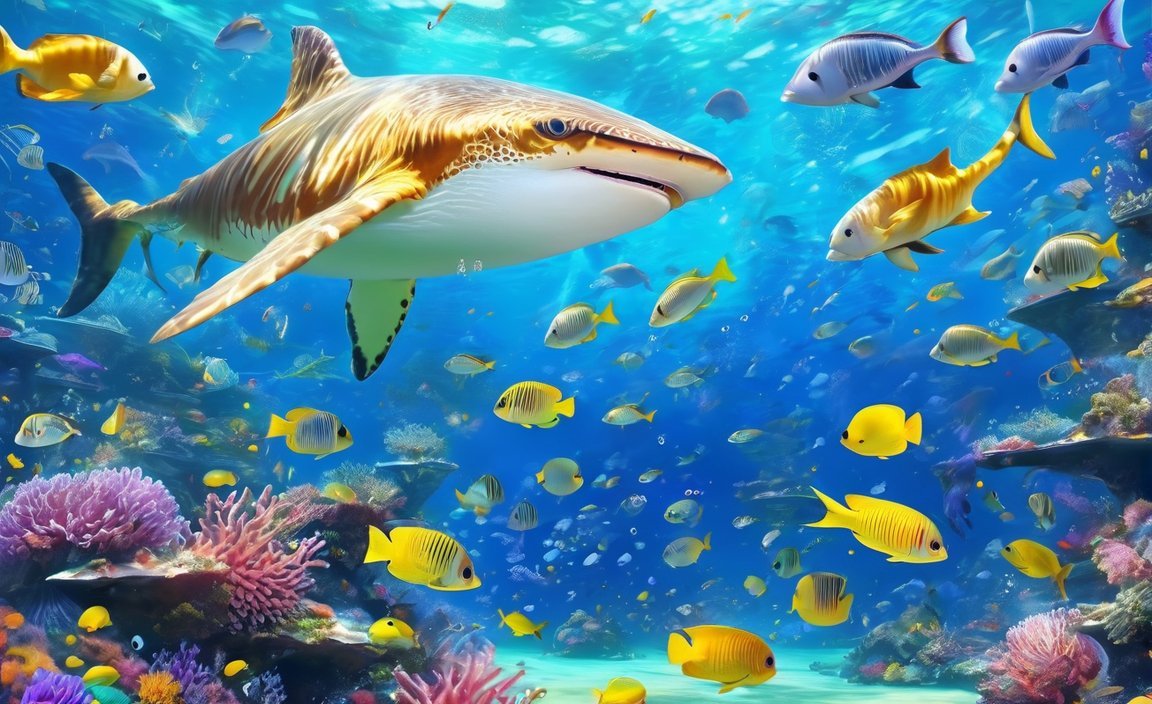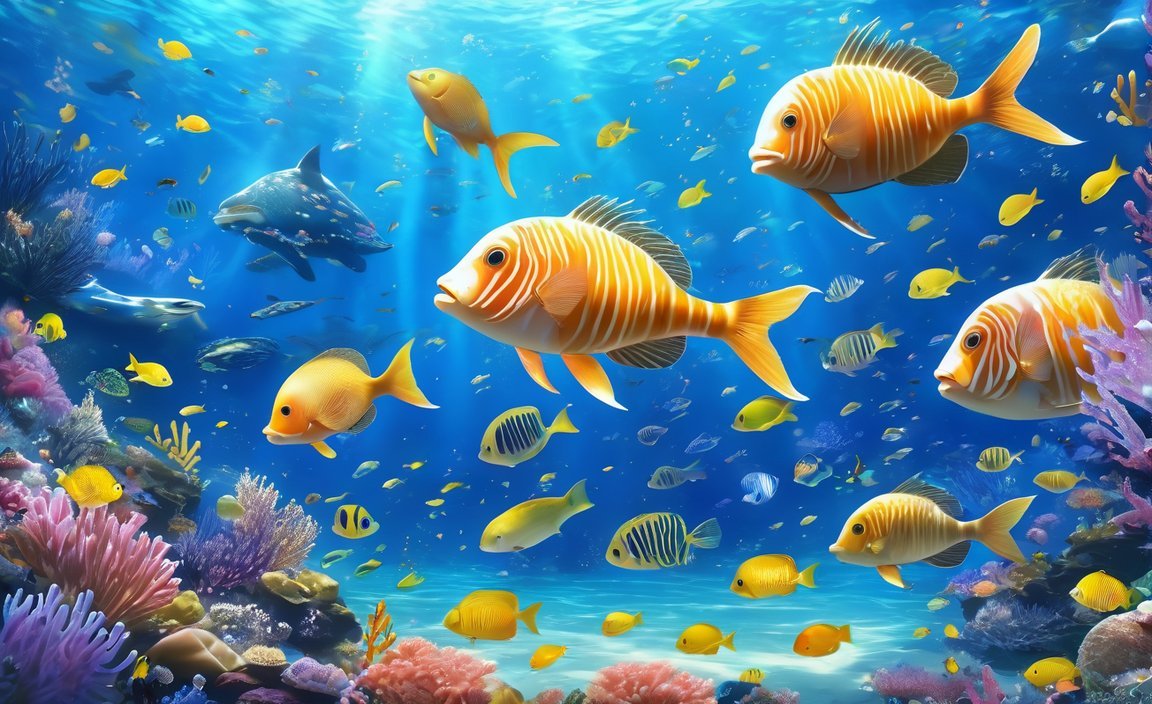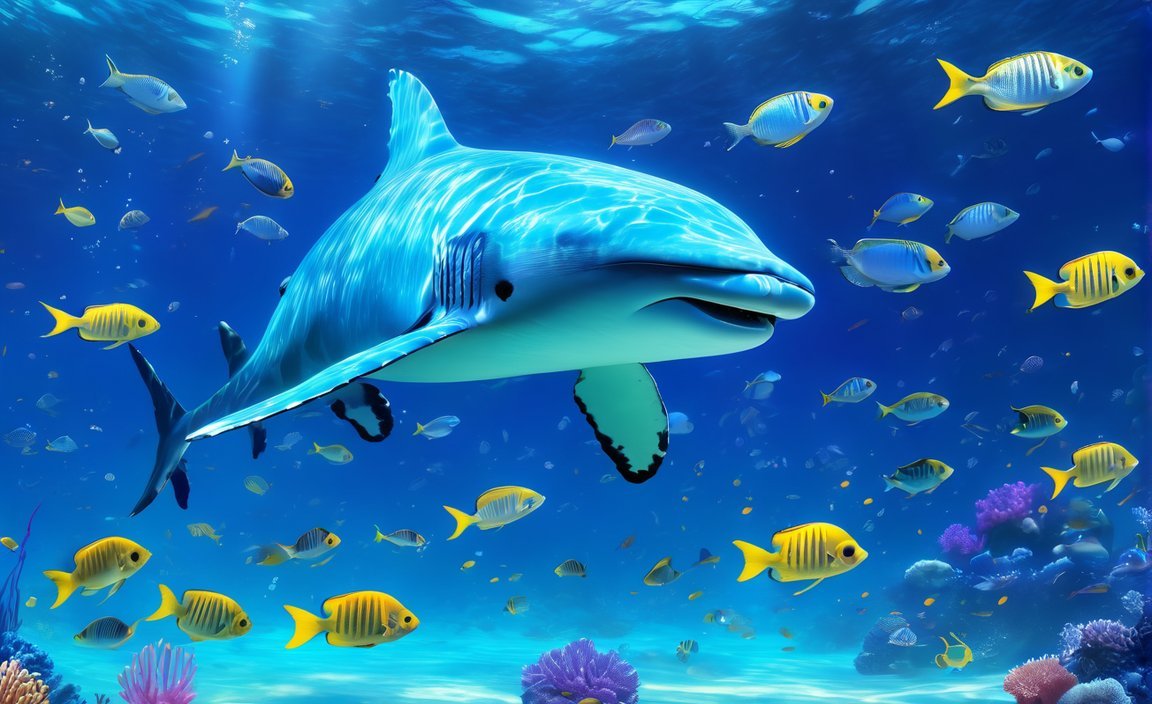Dive into the astonishing world of sea creatures and prepare to be amazed by the incredible facts that lie beneath the shimmering surface. From the depths of the ocean to the sandy shores, these captivating creatures continue to astound us with their remarkable adaptations, intelligence, and wondrous lifestyles. Join us on an awe-inspiring journey as we uncover the astonishing facts about sea creatures that will leave you in awe of the mesmerizing world that lies beneath the waves.
Key Takeaways:
- Jellyfish have been around for over 650 million years, making them older than both dinosaurs and sharks.
- The blue whale is not only the largest sea mammal but also the largest known animal on Earth.
- Male octopuses remain confused for life after mating, while seahorse males carry and give birth to babies.
- Electric eels can generate enough electricity to power ten light bulbs.
- Sea turtles have existed since the time of dinosaurs.
- Dolphins sleep with only half of their brain and one eye open to watch for predators.
- About 80% of all life forms exist underwater in seas.
- Whales communicate by singing.
- Ocean animals include a wide range of species, including animals, plants, and other organisms.
Amazing Facts about Sea Creatures

Sea creatures have fascinated humans for centuries with their fascinating adaptations, intelligence, and wondrous lifestyles. From ancient jellyfish to giant blue whales, the underwater world is filled with astonishing beings. In this article, we will dive deep into the captivating realm of sea creatures and explore some truly amazing facts that will leave you in awe.
1. Jellyfish: Ancient Ocean Dwellers
Did you know that jellyfish have been around for more than 650 million years? This means they outdate both dinosaurs and sharks! These translucent creatures have survived through time, adapting to their ever-changing environment with remarkable grace.
2. Blue Whales: Majestic Giants of the Sea
The blue whale, the largest sea mammal, holds the title for being the largest known animal in the world. These majestic giants can grow up to 98 feet long and weigh around 200 tons. Imagine encountering one of these impressive creatures while exploring the ocean depths!
3. Octopuses: Peculiar Mating Behavior
Male octopuses have a unique and perhaps slightly unfortunate experience after mating. Once they mate with a female, they remain confused for life. This fascinating behavior showcases the intricate complexities of octopus social dynamics.
4. Seahorses: Unconventional Parenting
Seahorse males challenge our traditional notions of parenting. While most male animals play little to no role in raising their offspring, seahorse males take on the responsibility of carrying and protecting their babies. These nurturing fathers even give birth to the baby seahorses!
5. Electric Eels: Shockingly Powerful
Electric eels possess an incredible superpower. They can produce enough electricity to power ten light bulbs! This shocking ability allows them to stun their prey and defend themselves against potential threats. Truly electrifying, isn’t it?
6. Sea Turtles: Ancient Survivors
Sea turtles have graced our planet for millions of years. They have been alive since the time of dinosaurs, and their existence is a testament to their resilience. These remarkable creatures migrate across vast distances, showing us the true wonders of the ocean.
7. Dolphins: Intelligent and Hypervigilant
Dolphins are known for their intelligence and social behavior, but did you know they have a unique way of sleeping? Dolphins sleep with only half of their brain at a time, while the other half remains awake to watch out for predators and threats. This hypervigilance ensures their safety even when they’re resting.
8. Ocean: A World of Abundant Life
The seas hold a secret hidden beneath their shimmering surface. Almost 80% of all life on Earth survives underwater in oceans! From stunning coral reefs to mesmerizing schools of fish, the underwater world is teeming with diverse organisms, each playing a vital role in maintaining our planet’s delicate balance.
9. Whales: The Singing Giants
Whales communicate in a unique and enchanting way. They sing melodious songs, which can travel for vast distances through the water. These captivating melodies serve various purposes, including finding mates, navigating, and even establishing social bonds. The magic of whale songs echoes through the vast expanse of the ocean.
10. Ocean Animals: A Diverse Array
The ocean is home to a vast array of animals, plants, and other organisms. From tiny plankton that form the base of the food chain to enormous predators like sharks and killer whales, the aquatic ecosystem is a complex web of life. Each species has its own remarkable features and adaptations that contribute to the richness of our seas.
The world beneath the waves is filled with wonders beyond our imagination. Sea creatures offer remarkable examples of adaptation, intelligence, and survival. Exploring their astonishing world reveals not only their uniqueness but also our own connection to the vast and mysterious ocean. So, let’s continue to marvel at these amazing facts about sea creatures, inspiring us to protect and cherish the priceless treasures of our seas.
Here are some fascinating facts about ocean animals that will leave you amazed! Want to dive deeper into the wonders of the ocean? Check out these amazing facts about ocean animals.
amazing facts about ocean animals
Discover the captivating world of sea animals with these mind-blowing facts! From the incredible adaptations to their mesmerizing behaviors, there is so much to learn. Dive in and explore these amazing facts about sea animals.
amazing facts about sea animals
Uncover the secrets of the ocean’s most extraordinary creatures with these astonishing facts! From the majestic whales to the tiny critters, these amazing ocean animal facts will leave you in awe.
Prepare to be amazed by the wonders of the sea! Dive into a world filled with fascinating sea life and explore these incredible facts. Discover the beauty and marvels of the ocean with these amazing sea life facts.
Did you know that there are specific laws in Texas regarding alligator snapping turtles? Learn about these laws and more regarding the alligator snapping turtle in Texas.
alligator snapping turtle Texas laws
Looking for animal-assisted therapy activities? Explore the powerful impact of animals in therapeutic settings and discover various activities that can enhance the therapeutic process.
animal-assisted therapy activities
The Extraordinary Camouflage Techniques of Cuttlefish

Cuttlefish are remarkable creatures that possess an array of extraordinary camouflage techniques. They have the remarkable ability to change their color, texture, and shape to seamlessly blend in with their surroundings. This camouflage is not only for protection but also for hunting and communication purposes. Let’s dive deeper into the mesmerizing world of cuttlefish and explore their astonishing camouflage techniques.
Masters of Concealment: Cuttlefish have the incredible ability to change the color and pattern of their skin in an instant, allowing them to become practically invisible to predators and prey alike. Their skin contains specialized pigments and cells called chromatophores, which expand or contract to create different colors and patterns. By rapidly controlling these cells, cuttlefish can mimic the colors and textures of their environment, effectively becoming hidden in plain sight.
Adaptive Camouflage: Cuttlefish are highly adaptable when it comes to camouflage. They can match the colors and patterns of their surroundings, whether it’s blending into coral reefs, rocky seabeds, or even sandy seabed. The speed and accuracy with which they can adjust their appearance is truly astonishing.
Mimicry Skills: Cuttlefish not only camouflage themselves to blend in with their environment, but they can also mimic other objects and animals around them. From imitating rocks and seaweed to resembling poisonous or dangerous marine creatures, cuttlefish use their shape-shifting abilities to deceive predators and potential prey. This mimicry is incredibly detailed, down to the smallest details like the texture of their skin.
Strategic Disguise: Male cuttlefish display another level of camouflage expertise. During courtship, some male cuttlefish have the ability to disguise themselves as females to avoid competition from other males. This tactic allows them to approach females without arousing suspicion, increasing their chances of successful mating.
Intelligence and Perception: Cuttlefish exhibit remarkable intelligence, with a brain-to-body ratio that rivals that of some mammals. Despite being colorblind, they have exceptional vision and can still detect and mimic colors and patterns accurately. This demonstrates their advanced perception skills and cognitive abilities.
Research and Inspiration: Scientists have been studying cuttlefish extensively to understand the mechanisms behind their astonishing camouflage abilities. By unraveling the secrets of their adaptable skin and complex behaviors, researchers hope to develop new technologies and materials that can replicate or surpass the cuttlefish’s incredible camouflage capabilities.
The extraordinary camouflage techniques of cuttlefish truly showcase the marvels and wonders of marine life. Their ability to change color, texture, and shape with such precision is a testament to their remarkable adaptations and intelligence. These masters of disguise continue to inspire and astound researchers and enthusiasts alike, urging us to delve deeper into the mysteries of the ocean.
Key Takeaways:
- Cuttlefish are experts at camouflage, using their ability to change color, texture, and shape to blend in with their surroundings.
- They can mimic objects and animals, displaying incredible artistic detail and deception.
- Male cuttlefish can disguise themselves as females to gain a mating advantage.
- Despite being colorblind, cuttlefish have excellent vision and can still identify colors and patterns accurately.
- Scientists study cuttlefish to uncover the secrets behind their camouflage and apply their findings to innovative technologies.
Sources:
- Treehugger – 8 Facts About the Amazing Cuttlefish
- National Geographic – Cuttlefish, facts and photos
The Surprising Longevity of the Greenland Shark
The Greenland shark is an extraordinary creature that inhabits the depths of the ocean. With its astonishing longevity, this species has captured the fascination of scientists and marine enthusiasts alike. In this article, we will explore the remarkable facts about the surprising longevity of the Greenland shark and unveil the secrets of its incredible lifespan.
Unveiling the Secrets of Longevity
The Greenland shark is renowned for its exceptional lifespan. Research has revealed that these amazing creatures can live for up to 400 years, making them one of the longest living species on Earth. In fact, they hold the title for the longest living vertebrate, surpassing even the giant tortoise. The discovery of their longevity has astounded scientists and opened up new avenues for research into the aging process.
A Deep-Dwelling Wanderer
To unravel the mysteries of the Greenland shark’s longevity, it is important to understand its unique habitat. These fascinating creatures thrive in the dark depths of the ocean, venturing as deep as 3,000 feet below the surface. In these frigid waters, the Greenland shark roams the vast expanses, embodying the essence of resilience and adaptability.
Adaptations for Survival
The Greenland shark has evolved remarkable adaptations to survive and thrive in its harsh environment. One of its standout features is its ability to withstand extreme cold. As a cold-blooded species, these sharks prefer colder waters and have developed specialized physiological mechanisms to thrive in such conditions.
Sightless Survivors
Interestingly, the Greenland shark is not known for its keen eyesight. In fact, it is half-blind, relying on its other senses to navigate the dark depths of the ocean. This unique adaptation has enabled these sharks to compensate for their lack of vision and successfully hunt for prey.
Toxic Tidbits
While the Greenland shark’s longevity is awe-inspiring, it is important to note that their meat is toxic. Consuming their flesh can lead to a range of health issues, including dizziness and even paralysis. This toxicity is caused by high levels of trimethylamine oxide (TMAO) in their tissues. As a result, human consumption of Greenland shark meat is strictly discouraged.
Separating Facts from Fiction
There have been claims suggesting that the oldest Greenland sharks could be as old as 500 years. However, these rumors are likely untrue. While the exact lifespan of these creatures is still under investigation, current scientific evidence suggests a maximum lifespan of approximately 400 years.
Key Takeaways:
- The Greenland shark is one of the longest living species on Earth, with a potential lifespan of up to 400 years.
- These remarkable creatures thrive in the depths of the ocean, venturing as deep as 3,000 feet.
- The Greenland shark has evolved unique adaptations to withstand extreme cold and navigate its environment despite being half-blind.
- Consumption of Greenland shark meat is not recommended due to its toxic properties.
- While claims of 500-year-old Greenland sharks exist, current research suggests a maximum lifespan of around 400 years.
Sources:
– Fact Animal – Greenland Shark
– National Geographic – Greenland Shark
The Astonishing Regeneration Abilities of Starfish
Starfish are truly remarkable creatures with the ability to regenerate their limbs and even their entire bodies. It’s a phenomenon that sets them apart from many other animals in the animal kingdom. In fact, starfish can regrow their entire body from just a single arm. This astonishing regeneration ability has captured the interest and curiosity of scientists and marine enthusiasts alike.
The regeneration process of starfish is truly fascinating. When a starfish loses an arm, a process known as autotomy, it has the remarkable ability to regenerate that lost arm. The cells at the site of the injury divide and multiply, forming a specialized group of cells called a blastema. This blastema has the incredible ability to generate all the cell types needed to form a new arm, including muscles, nerves, and even skeletal structures.
But the regeneration abilities of starfish don’t just stop at regrowing arms. They can also regenerate other parts of their bodies, such as their central disc and even their organs. This remarkable capacity for regeneration allows starfish to recover from injuries that would be fatal for many other organisms.
So, what makes starfish so unique in their regeneration abilities? One explanation lies in their unique biology. Starfish have a decentralized nervous system, which means that their nerve cells are distributed throughout their bodies instead of being concentrated in a central brain. This decentralized nervous system allows them to control and coordinate their regenerative processes at the site of the injury.
Additionally, starfish possess a high concentration of specialized cells called neoblasts. These neoblasts are responsible for tissue regeneration and can differentiate into different cell types, allowing for the regrowth of lost body parts. The combination of a decentralized nervous system and a high presence of neoblasts gives starfish their incredible regenerative abilities.
But why do starfish possess these astonishing regeneration abilities? One theory is that it enables them to escape from predators. When a starfish is under attack, it can purposely shed one or more of its arms to distract the predator, while it escapes. The ability to regenerate these lost arms allows the starfish to survive and continue its life in the ocean.
In conclusion, the regeneration abilities of starfish are truly astonishing. They possess the incredible capacity to regrow their limbs and even their entire bodies. This ability is possible due to their decentralized nervous system, the presence of neoblasts, and a unique biological process. The astonishing regeneration abilities of starfish continue to captivate scientists and serve as a reminder of the incredible diversity and adaptability of marine life.
Key Takeaways:
- Starfish have the remarkable ability to regenerate their limbs and even their entire bodies.
- The regeneration process involves the division and multiplication of cells at the site of the injury, forming a blastema.
- Starfish possess a decentralized nervous system and a high concentration of specialized cells called neoblasts, which contribute to their regenerative abilities.
- The regenerative abilities of starfish enable them to escape from predators by sacrificing and regenerating their lost limbs.
- The astonishing regeneration abilities of starfish highlight the incredible diversity and adaptability of marine life.
Sources:
– Carnegie Mellon University: Neuron regeneration in starfish
– Wikipedia: Starfish regeneration
FAQ
Q1: How long have jellyfish been around compared to other ancient creatures?
A1: Jellyfish have been around for more than 650 million years, outdating both dinosaurs and sharks.
Q2: What is the largest sea mammal in the world?
A2: The blue whale, the largest sea mammal, is also the largest known animal in the world.
Q3: What happens to male octopuses after mating?
A3: Male octopuses remain confused for life after mating.
Q4: Do seahorse males give birth to their young?
A4: Yes, seahorse males carry babies and give birth.
Q5: How much electricity can electric eels produce?
A5: Electric eels can produce enough electricity to power ten light bulbs.
















